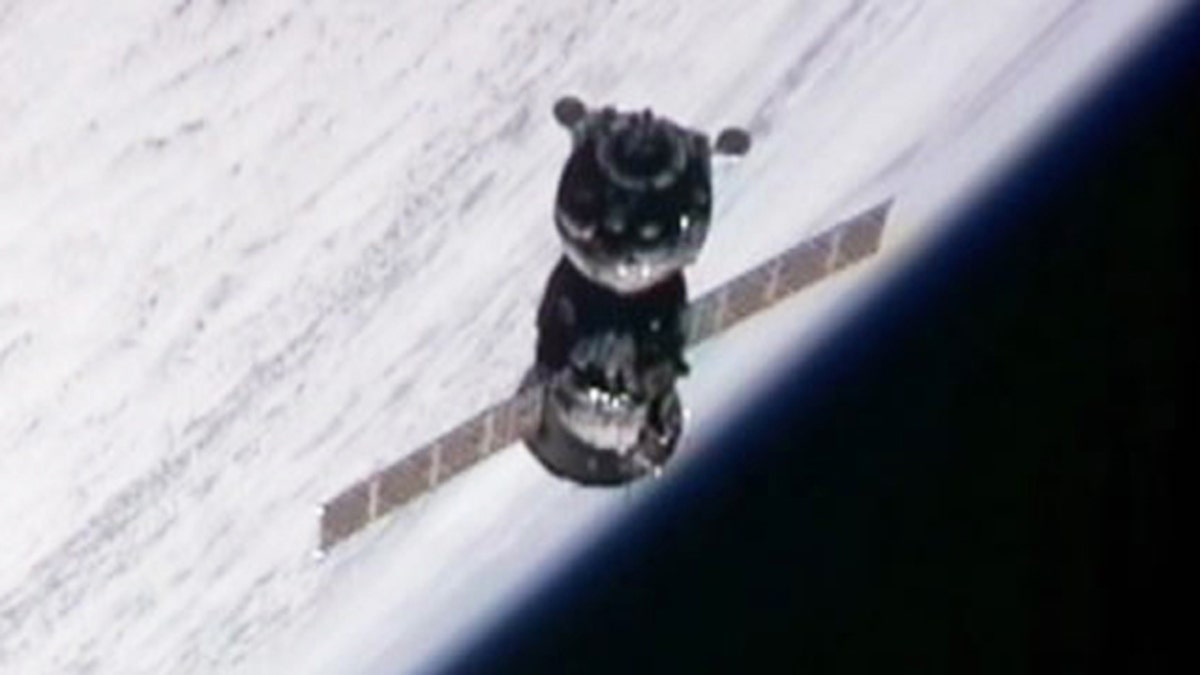
Oct. 9: The new Soyuz TMA-01M is seen closing in on the International Space Station with three new crewmembers for the Expedition 25 crew in this view from a camera on the station's exterior. (Space.com)
A NASA astronaut and two Russian cosmonauts successfully docked their Soyuz spacecraft at the International Space Station on Saturday to begin a months-long stay on the orbiting laboratory.
The new Soyuz TMA-01M spacecraft linked up with the space station at 8:01 p.m. EDT, ending a trip that began with a launch two days earlier from Baikonur Cosmodrome in Kazakhstan.
Riding aboard the Soyuz are American astronaut Scott Kelly, Alexander Kaleri and Oleg Skripochka. The three men are expected to spend more than five months aboard the International Space Station.
"We have contact," one of the spaceflyers said as the Soyuz TMA-01M vehicle docked at the space station. Both spacecraft were flying more than 220 miles above the southern Pacific Ocean, just off the coast from Chile.
The trio rounded out the Expedition 25 crew already aboard space station – commander Doug Wheelock and flight engineer Shannon Walker, both of NASA, and Russian flight engineer Fyodor Yurchikhin.
Astronaut Twin in Space
All six spaceflyers shared warm hugs and smiles after the hatches between their two spacecraft were opened.
One of them, Scott Kelly, got a special call from his twin brother Mark – who is also a NASA astronaut.
The Kelly brothers are both U.S. Navy captains and the world's only identical twin astronauts.
They plan to meet up in March 2011 when Mark Kelly will lead NASA's final flight of the shuttle Endeavour, which will visit the space station while Scott is in command.
During his call, Mark Kelly joked that he was actually Scott and that the twins had switched places before the Soyuz launch because "six months in space is a long time."
In reality, Scott Kelly is in space, but he laughed out loud at his older (by six minutes) brother's joke.
"That is pretty funny," Scott said with a smile.
Mark promised to bring his brother's stuff to the space station when he visits next year.
Busy Mission Ahead
In November, Scott Kelly will take command of the station's Expedition 26 mission, when Wheelock, Walker and Yurchikhin return home.
During their stay, the astronauts will be involved in general upkeep of the station, as well as a variety of scientific research and experiments.
Those experiments began at launch, which marked the first flight test of Russia's new Soyuz vehicle model, the TMA-01M, which features upgrade navigation systems among other improvements.
"The main goal is to keep the station in good shape and to maintain all the equipment working, and to perform a huge scientific program for all the international partners," Kaleri said in a preflight interview. "For me personally, my main task will be to test the upgraded Soyuz in flight.
So for me, the most important and most valuable flight stages will be from the launch to the docking, from undocking to landing."
While this flight is Skripochka's first trip into space, his crewmembers, Kelly and Kaleri, are both veteran spaceflyers who have made previous visits to the space station.
Space Anniversary Coming Soon
The crew will be aboard the space station during the 10th anniversary of the first crew ever sent to the orbiting laboratory. That first crew, the three-man Expedition 1, launched on Oct. 31, 2000 and arrived on Nov. 2 of that year.
In 2000, the space station only consisted of two Russian modules and a U.S. connecting node. Today, $100 billion space station has more than 10 rooms, as much living space as a Boeing 747 jumbo jet, and a main truss as long as a football field. It is the product of five difference space agencies and 15 different countries.
The station's Expedition 25 crew plans to host two visiting space shuttle flights – the shuttle Discovery in November and Endeavour in February next year – plus the arrival of European and Japanese unmanned freighter ships.
Endeavour's STS-134 mission next year – commanded by Mark Kelly – is the last shuttle flight currently set on NASA's books, though one more shuttle trip may be added to the lineup if President Obama signs the NASA authorization bill recently passed by Congress and it passes through an appropriation review.
